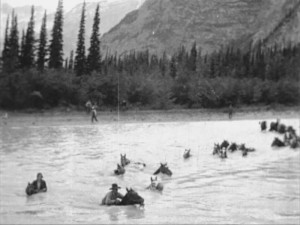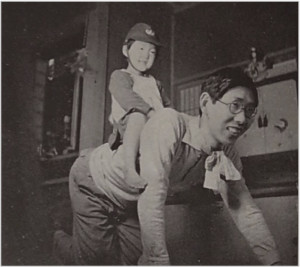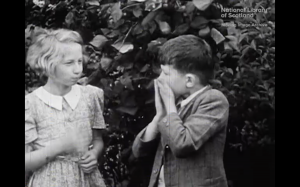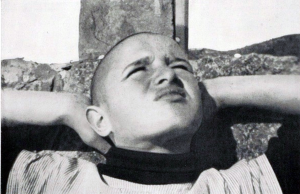
"Shows an expedition through northeastern British Columbia by Mary Gibson Henry, Pennsylvania botanist and plantswoman. Mrs. Henry was interested in the legendary "Tropical Valley" of northern B.C., where the warmth of hot springs supposedly fostered vegetation not otherwise found in the region. The film was shot in the summer of 1931, during the first of four such journeys she made in the period 1931-1935. Mrs. Henry was accompanied by her husband, Dr. J. Norman Henry; four of her children; topographer Knox McCusker (of the Dominion Topographical Surveys Branch); Dr. B.H. Chandler, a surgeon friend; and outfitter S. Clark, as well as various wranglers. The second and third reels of this three-reel film show the party of 16 travelling by pack-train, crossing rivers, caching food, and fishing, as well as some camp scenes. At an encampment of "Grand Lake Indians" on the Tetsa River, they engage Charlie Macdonald, the chief's son, to guide them to Toad Hot Springs on the Toad River, but they do not proceed north to Liard Hot Springs. On the return trip south, stops include St. Paul's Lake, Henry River, and Lake Mary and Lake Josephine [named after the Henry's daughters]; these place names do not seem to have become official. Following the Peace River, they arrive at Hudson's Hope (having travelled 800 miles in 79 days), and continue down river to Taylor Flats." (BC Archives)
The title given above is a supplied title based on the film contents. The actual title of the film is unknown, since it survives as reels 2 and 3 of 3 -- and the actual title and credits (if any) would likely have been at the start of reel 1.
"One of the most difficult of amateur subjects, a record of a child's vacation, is presented most ably in Adirondack Adventure, by Frank Gunnell, ACL. The photography was a joy to behold and showed quite clearly that a great deal of care and experience was back of it. Fine outdoor lighting, which made the most of every scene, predominated. The continuity of this competent picture was developed in such a fashion as to feature Mr. Gunnell's small son naturally and unobtrusively. Incidents which make up the picture are handled clearly and yet with a light touch. Only a movie maker would appreciate the fact that the sequences were far from casual but, instead, were staged carefully. The real charm of a summer vacation has been preserved in this fine picture." Movie Makers, Dec. 1935, 534.
"a burlesque on “Sherlock Holmes” (HMHT 1933: 446).

"Mimae edited together a sequence of her husband and their small son at home (the boy pretending to be riding his war-horse father), with a scene capturing a crowd of people offering silent prayers, which Mimae shot on location in Ginza. This topic and narrative structure demonstrate how her film visualized the social and political sentiments in a way to promote the war efforts, even though the film itself also appeared as a family film." - Noriko Morisue, "Filming the Everyday: History, Theory, and Aesthetics of Amateur Cinema in Interwar and Wartime Japan" (Yale University: PhD Dissertation, 2020): 203.

"Exploits of a boy and girl scrumping fruit and annoying a gardener and an angler. Sickness is the reward for gluttony and the doctor dispenses castor oil to the miscreant." (EAFA Database)

"a soggetto lungho normale"/Fiction feature film
"Arco felice, realizzato da Domenico Paolella: collaborazione generale di Remigio del Grosso. È’tra i film a soggetto, a formato ridotto, quello che più di tutti gli altri tiene conto della importanza dello scenario - montaggio, della continuity per dirla con una precisa espressione. Infatti la continuità narrativa e visiva e mantenuta costante e precisa dal principio alla fine, in unione ad una singolare efficacia descrittiva, piuttosto sintetica dell'ambiente e dei tipi: sono questi ragazzi della strada e del porto, gli scugnizzi napoletani, di cui il film si propone di mostrare la rigenerazione, compiuta attraverso la organizzazione dei ragazzi nelle colonie permanenti dell'Opera Nazionale Balilla. La dimostrazione e assolutamente priva di ogni elemento retorico e il racconto non ha incertezze; assolutamente senza didascalie, il film non richiederebbe nemmeno il parlato, tanto gli autori si sono preoccupati di rendere tutto attraverso immagini, in un procedere di andante mosso che ben si addice al tema del film. Sopratutto e chiaramente espresso il contrasto tra uno dei ragazzi e gli altri; questi ormai nella via della rigenerazione, quello invece ancora perplesso e scontroso di fronte alla nuova vita· i due motivi sono seguiti parallelamente secondo il sistema caro ai suoi tempi a Griffith, col mostrare i ragazzi inquadrati nelle loro diverse attività, in una gita, e l'altro solo di fronte al mare; il ragazzo fugge ne alcuno lo richiama; ma quando si trova nel porto, una assordante confusione lo invade ed egli ritorna alla colonia al momento dell'ammaina bandiera. Forse in quest'ultima sequenza il film riesce un po' sbrigativo; ma tuttavia anche qui come nel resto si avverte la freschezza e la sincerità della narrazione e delle espressioni degli interpreti scelti dai realizzatori tra gli stessi ragazzi di una colonia."
"Arco felice, directed by Domenico Paolella: general collaboration by Remigio del Grosso. More than any other small format fiction film, it takes into account the importance of the relationship between screenplay and the montage, of the continuity, to use a precise expression. In fact, the narrative and visual continuity is kept constant and precise from the beginning to the end, together with an original rather concise description of the environment and characters: these boys of the street and of the port, the Neapolitan street urchins, of which the film proposes to show the rehabilitation, accomplished through the organization of the boys in the permanent camps of the Opera Nazionale Balilla, The development is absolutely devoid of any rhetorical element and the story has no ambiguities; absolutely without inter-titles, the film would not even require sound, to such an extent have the authors have taken care to render everything through images, in a proceeding of a moving andante that well suits the theme of the film. Above all, the contrast between one of the boys and the others is clearly expressed; the latter are now on the road to rehabilitation, while the former is still perplexed and surly in the face of his new life. The two motifs are followed in parallel according to the system dear to Griffith in his day, showing the boys framed in their various activities while on an excursion, and the other alone in front of the sea; the boy runs away and no one calls him back, but when he finds himself in the port, a deafening confusion invades him and he returns to the colony at the moment of the lowering of the flag. Perhaps in this last sequence the film is a bit hasty, but here, as in the rest, you can feel the freshness and sincerity of the narrative and the expressions of the interpreters chosen by the makers among the same boys of a camp."
—Il ventuno 28 (Review of the G.U.F. of Venice), May 1935, p. 16
"As We Forgive, produced by the Religious Motion Picture Foundation and filmed by Kenneth F. Space, with the technical assistance of Dan Lindsay, is a fine example of weaving the theme of the picture into the very warp and woof of its photographic material. The makers of this photoplay had a sincere and simple theme to present, and the excellence of their presentation lay in the fact that every detail of the handling, both in technique and continuity, was done sincerely and simply. It is this carefully worked out unity of treatment with theme that enables the film to serve as a model for producers of photoplays with a message. The filmers particularly are to be congratulated on their handling of child actors, one of the most difficult problems to be solved successfully in any field of the drama. From the technical point of view, we may remark the well exposed interiors, in which the lighting was carefully planned to give the effect of normal illumination; the fine photographic quality displayed in the closeups and camera angles and the smooth unity of the entire technical handling." Movie Makers, Dec. 1936, 542.
"At the Sandpits is perhaps Crawley's first completed work, produced when he was a teenager; Crawley went on to make many award-winning amateur films before turning professional in the 1940s as a producer of industrial films. Employing rapid cutting, trick photography, and imaginative scenarios, At the Sandpits conveys a strong sense of dynamic action in a short film about a family picnic. The film begins by showing the preparation of sandwiches for a picnic; after showing the meal in a few deft shots, the adults are seen relaxing, while the kids and pets, shot from extreme low angle in slow motion, run toward the sandpits. The film continues with short but carefully constructed sequences of the kids pretending to be buried alive in the sand, having a baseball game, and then returning home, tired. Finally, the film concludes with a strange dream sequence, employing trick photography, in which three girls appear decapitated behind a sheet" Tepperman, 173.
"Various family members are seen in the garden of a large house, possibly The Beeches. A woman and baby sit on a blanket in the middle of the lawn. A uniformed nanny joins them with another baby. Concludes with a shot of the two babies together on the blanket" (NWFA Online Database).
"Dramatic short of a frumpy woman's dream of the alternate course her life might take were she a beauty." oldfilm.org
Total Pages: 12